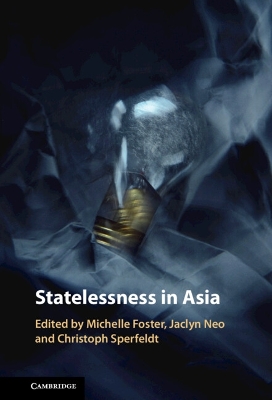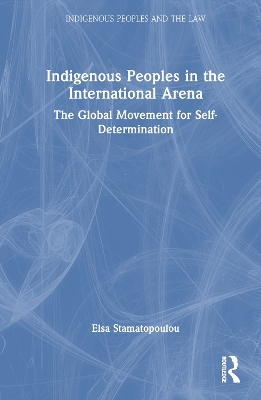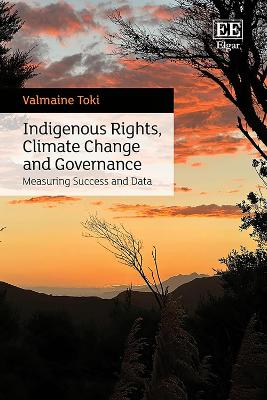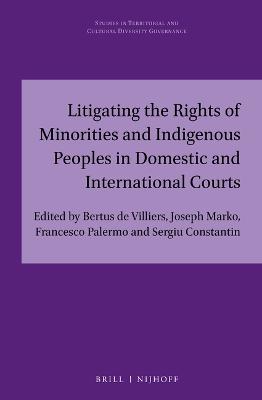Indigenous Peoples in the International Arena
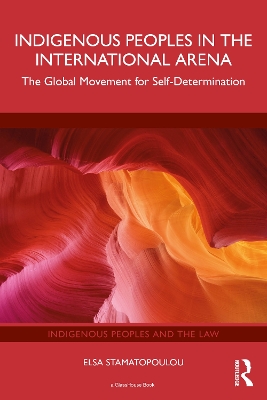 portes grátis
portes grátis
Indigenous Peoples in the International Arena
The Global Movement for Self-Determination
Stamatopoulou, Elsa
Taylor & Francis Ltd
07/2024
312
Mole
9781032734156
Pré-lançamento - envio 15 a 20 dias após a sua edição
Descrição não disponível.
Acknowledgements xii
List of Abbreviations xiv
Introduction 1
A. Historical Context 4
B. Issues and Challenges 6
C. The Appeal to Human Rights 8
D. Changes Over Time 14
E. Indigenous Participation in Indigenous Rights-Related UN Bodies 18
F. Self-Determination, Corrective Exceptionalism, and Other Theoretical Underpinnings 19
G. The Purpose of This Book 23
H. Methodologies 25
I. The Chapters 27
1 The Formative Years 33
A. Indigenous Voices 33
B. Participation as Methodology: The Pivotal UN Study 47
C. Stepping Stones: Human Rights and Antiracism (1977 and 1981) 50
D. The First Indigenous-Related Body at the UN (1982) 55
E. Consolidating Direct Participation (1983) 64
F. Indigenous Peoples Are Not Minorities 68
2 The Victory of Nondefinition 75
A. Why There Is No Definition of "Indigenous Peoples" 75
B. What Is at Stake in a Definition? Palestinian Participation in the UN's Indigenous-Related Bodies 91
3 The Rise of Corrective Exceptionalism 103
A. Indigenous Peoples Are Not Nongovernmental Organizations (NGOs) 105
B. UN Commission on Human Rights Working Group on the Draft Declaration 110
C. Moments of Making History 113
D. Building Documentation 119
1. Reporting Human Rights Abuses 119
2. Saving Papers from the Fire 121
E. The UN Voluntary Fund for Indigenous Populations: Winning Financial Support 124
F. Confirming Direct Participation: The UN Permanent Forum on Indigenous Issues 130
4 Self-Representations and Demands of Indigenous Peoples 137
A. Special Features of the International Indigenous Peoples' Movement 139
B. Who Are the Indigenous Representatives at International Fora? 141
C. The Drafting of the United Nations Declaration on the Rights of Indigenous Peoples 145
1. Role of the UN Working Group on Indigenous Populations 145
2. Role of the UN Commission on Human Rights and Its Working Group on the Draft Declaration (1996-2005) 148
3. Role of the UN Permanent Forum on Indigenous Issues 150
4. Role of the General Assembly 151
D. Conceptual Contributions of Indigenous Peoples to Human Rights Norms 154
1.The Controversy Over Collective Rights 155
E. Significance and Content of the UNDRIP 160
1. What Is the Declaration About? 163
2. Unsettling and Resetting Relations with States 170
F. Indigenous Philosophies, Protocols, Ceremonies, and Prophecies 171
1. Toward Legal Pluralism Through Indigenous Participation 171
2. Conversing Symbolisms 173
3. Writing Letters 174
4. The Hopi Prophecy and the "House of Mica" 175
5. Opening of UN Meetings by "The People of the Land" 180
6. Saying a Prayer, Smoking a Peace Pipe, Exhibiting Indigenous Arts, and Protecting Sacred Staffs 183
7. Evolving Protocols and Expectations 186
G. Participation of Indigenous Women 188
1. How Does UNDRIP Cover Indigenous Women? 193
2. Indigenous Women and Equality: Is the Principle of Nondiscrimination Enough? 194
3. Parameters of Indigenous Women's Rights 195
4. Exercising Cultural Human Rights 197
H. Participation of Indigenous Youth 201
I. The First Indigenous Leader to Meet with a UN Secretary-General: The Yanomami Case 203
J. The Role of Researchers and Academics 210
K. Impacts, Potential, and Limits of Indigenous Peoples' Participation 215
1. Impacts 215
2. Achievements 216
3. Challenges 218
4. Expectations 219
5. Limits in the Midst of Achievements 219
L. The Vision of Enhanced Participation 225
5 The Right to Self-Determined Development 243
A. Introduction 243
1. Methodological and Conceptual Questions 246
B. Navigating the Maze of the Interstate System 247
1. Specificity in Addition to Universality 250
2. Indigenous Peoples' Indirect Participation 252
C. Strengthening Indigenous Peoples' Participation 252
1. Strategies for Inclusion and Participation 254
2. International Agencies' and States' Interactions 256
3. Significance of Articles 41 and 42 of UNDRIP 258
4. Adoption of Specific Policies on Indigenous Peoples' Issues 261
5. Achievements within International Organizations 263
6. Avoiding "Over-Institutionalization" 264
D. Obstacles and Opportunities for Participation 266
1. Challenges within the Interstate System 266
2. A "Personalized" Encounter with Globalization: The WTO 267
3. Is Being "for All Children" Enough for Indigenous Children? UN Children's Fund 269
4. UN Development Program and the Chittagong Hill Tracts of Bangladesh 271
5. Is UN Expertise Adequate to Decide UN Projects in Indigenous Communities? UN DESA 275
6. Leadership in Climate Change Solutions 276
7. Opportunities for the Future 278
8. The Human Rights-Based Approach 279
E. Sustainable Development Goals and Indigenous Participation 281
1. Lessons Learned from the Millennium Development Goals 282
2. Priorities of Indigenous Peoples in the SDGs 284
3. Indicators for Measuring Progress for Indigenous Peoples 287
4. Data Collection with, on, and for Indigenous Peoples 288
F. How to Define Good Examples of Indigenous Peoples' Participation? 291
1. Learning from Examples of International Agencies 291
2. The Good Example of the International Fund for Agricultural Development 294
3. Conclusion 296
Epilogue 302
Annex 1: List of Persons Interviewed 304
Index 307
List of Abbreviations xiv
Introduction 1
A. Historical Context 4
B. Issues and Challenges 6
C. The Appeal to Human Rights 8
D. Changes Over Time 14
E. Indigenous Participation in Indigenous Rights-Related UN Bodies 18
F. Self-Determination, Corrective Exceptionalism, and Other Theoretical Underpinnings 19
G. The Purpose of This Book 23
H. Methodologies 25
I. The Chapters 27
1 The Formative Years 33
A. Indigenous Voices 33
B. Participation as Methodology: The Pivotal UN Study 47
C. Stepping Stones: Human Rights and Antiracism (1977 and 1981) 50
D. The First Indigenous-Related Body at the UN (1982) 55
E. Consolidating Direct Participation (1983) 64
F. Indigenous Peoples Are Not Minorities 68
2 The Victory of Nondefinition 75
A. Why There Is No Definition of "Indigenous Peoples" 75
B. What Is at Stake in a Definition? Palestinian Participation in the UN's Indigenous-Related Bodies 91
3 The Rise of Corrective Exceptionalism 103
A. Indigenous Peoples Are Not Nongovernmental Organizations (NGOs) 105
B. UN Commission on Human Rights Working Group on the Draft Declaration 110
C. Moments of Making History 113
D. Building Documentation 119
1. Reporting Human Rights Abuses 119
2. Saving Papers from the Fire 121
E. The UN Voluntary Fund for Indigenous Populations: Winning Financial Support 124
F. Confirming Direct Participation: The UN Permanent Forum on Indigenous Issues 130
4 Self-Representations and Demands of Indigenous Peoples 137
A. Special Features of the International Indigenous Peoples' Movement 139
B. Who Are the Indigenous Representatives at International Fora? 141
C. The Drafting of the United Nations Declaration on the Rights of Indigenous Peoples 145
1. Role of the UN Working Group on Indigenous Populations 145
2. Role of the UN Commission on Human Rights and Its Working Group on the Draft Declaration (1996-2005) 148
3. Role of the UN Permanent Forum on Indigenous Issues 150
4. Role of the General Assembly 151
D. Conceptual Contributions of Indigenous Peoples to Human Rights Norms 154
1.The Controversy Over Collective Rights 155
E. Significance and Content of the UNDRIP 160
1. What Is the Declaration About? 163
2. Unsettling and Resetting Relations with States 170
F. Indigenous Philosophies, Protocols, Ceremonies, and Prophecies 171
1. Toward Legal Pluralism Through Indigenous Participation 171
2. Conversing Symbolisms 173
3. Writing Letters 174
4. The Hopi Prophecy and the "House of Mica" 175
5. Opening of UN Meetings by "The People of the Land" 180
6. Saying a Prayer, Smoking a Peace Pipe, Exhibiting Indigenous Arts, and Protecting Sacred Staffs 183
7. Evolving Protocols and Expectations 186
G. Participation of Indigenous Women 188
1. How Does UNDRIP Cover Indigenous Women? 193
2. Indigenous Women and Equality: Is the Principle of Nondiscrimination Enough? 194
3. Parameters of Indigenous Women's Rights 195
4. Exercising Cultural Human Rights 197
H. Participation of Indigenous Youth 201
I. The First Indigenous Leader to Meet with a UN Secretary-General: The Yanomami Case 203
J. The Role of Researchers and Academics 210
K. Impacts, Potential, and Limits of Indigenous Peoples' Participation 215
1. Impacts 215
2. Achievements 216
3. Challenges 218
4. Expectations 219
5. Limits in the Midst of Achievements 219
L. The Vision of Enhanced Participation 225
5 The Right to Self-Determined Development 243
A. Introduction 243
1. Methodological and Conceptual Questions 246
B. Navigating the Maze of the Interstate System 247
1. Specificity in Addition to Universality 250
2. Indigenous Peoples' Indirect Participation 252
C. Strengthening Indigenous Peoples' Participation 252
1. Strategies for Inclusion and Participation 254
2. International Agencies' and States' Interactions 256
3. Significance of Articles 41 and 42 of UNDRIP 258
4. Adoption of Specific Policies on Indigenous Peoples' Issues 261
5. Achievements within International Organizations 263
6. Avoiding "Over-Institutionalization" 264
D. Obstacles and Opportunities for Participation 266
1. Challenges within the Interstate System 266
2. A "Personalized" Encounter with Globalization: The WTO 267
3. Is Being "for All Children" Enough for Indigenous Children? UN Children's Fund 269
4. UN Development Program and the Chittagong Hill Tracts of Bangladesh 271
5. Is UN Expertise Adequate to Decide UN Projects in Indigenous Communities? UN DESA 275
6. Leadership in Climate Change Solutions 276
7. Opportunities for the Future 278
8. The Human Rights-Based Approach 279
E. Sustainable Development Goals and Indigenous Participation 281
1. Lessons Learned from the Millennium Development Goals 282
2. Priorities of Indigenous Peoples in the SDGs 284
3. Indicators for Measuring Progress for Indigenous Peoples 287
4. Data Collection with, on, and for Indigenous Peoples 288
F. How to Define Good Examples of Indigenous Peoples' Participation? 291
1. Learning from Examples of International Agencies 291
2. The Good Example of the International Fund for Agricultural Development 294
3. Conclusion 296
Epilogue 302
Annex 1: List of Persons Interviewed 304
Index 307
Este título pertence ao(s) assunto(s) indicados(s). Para ver outros títulos clique no assunto desejado.
Indigenous Rights;First Nations;indigenous voices;human rights;antiracism;corrective exceptionalism;united nations
Acknowledgements xii
List of Abbreviations xiv
Introduction 1
A. Historical Context 4
B. Issues and Challenges 6
C. The Appeal to Human Rights 8
D. Changes Over Time 14
E. Indigenous Participation in Indigenous Rights-Related UN Bodies 18
F. Self-Determination, Corrective Exceptionalism, and Other Theoretical Underpinnings 19
G. The Purpose of This Book 23
H. Methodologies 25
I. The Chapters 27
1 The Formative Years 33
A. Indigenous Voices 33
B. Participation as Methodology: The Pivotal UN Study 47
C. Stepping Stones: Human Rights and Antiracism (1977 and 1981) 50
D. The First Indigenous-Related Body at the UN (1982) 55
E. Consolidating Direct Participation (1983) 64
F. Indigenous Peoples Are Not Minorities 68
2 The Victory of Nondefinition 75
A. Why There Is No Definition of "Indigenous Peoples" 75
B. What Is at Stake in a Definition? Palestinian Participation in the UN's Indigenous-Related Bodies 91
3 The Rise of Corrective Exceptionalism 103
A. Indigenous Peoples Are Not Nongovernmental Organizations (NGOs) 105
B. UN Commission on Human Rights Working Group on the Draft Declaration 110
C. Moments of Making History 113
D. Building Documentation 119
1. Reporting Human Rights Abuses 119
2. Saving Papers from the Fire 121
E. The UN Voluntary Fund for Indigenous Populations: Winning Financial Support 124
F. Confirming Direct Participation: The UN Permanent Forum on Indigenous Issues 130
4 Self-Representations and Demands of Indigenous Peoples 137
A. Special Features of the International Indigenous Peoples' Movement 139
B. Who Are the Indigenous Representatives at International Fora? 141
C. The Drafting of the United Nations Declaration on the Rights of Indigenous Peoples 145
1. Role of the UN Working Group on Indigenous Populations 145
2. Role of the UN Commission on Human Rights and Its Working Group on the Draft Declaration (1996-2005) 148
3. Role of the UN Permanent Forum on Indigenous Issues 150
4. Role of the General Assembly 151
D. Conceptual Contributions of Indigenous Peoples to Human Rights Norms 154
1.The Controversy Over Collective Rights 155
E. Significance and Content of the UNDRIP 160
1. What Is the Declaration About? 163
2. Unsettling and Resetting Relations with States 170
F. Indigenous Philosophies, Protocols, Ceremonies, and Prophecies 171
1. Toward Legal Pluralism Through Indigenous Participation 171
2. Conversing Symbolisms 173
3. Writing Letters 174
4. The Hopi Prophecy and the "House of Mica" 175
5. Opening of UN Meetings by "The People of the Land" 180
6. Saying a Prayer, Smoking a Peace Pipe, Exhibiting Indigenous Arts, and Protecting Sacred Staffs 183
7. Evolving Protocols and Expectations 186
G. Participation of Indigenous Women 188
1. How Does UNDRIP Cover Indigenous Women? 193
2. Indigenous Women and Equality: Is the Principle of Nondiscrimination Enough? 194
3. Parameters of Indigenous Women's Rights 195
4. Exercising Cultural Human Rights 197
H. Participation of Indigenous Youth 201
I. The First Indigenous Leader to Meet with a UN Secretary-General: The Yanomami Case 203
J. The Role of Researchers and Academics 210
K. Impacts, Potential, and Limits of Indigenous Peoples' Participation 215
1. Impacts 215
2. Achievements 216
3. Challenges 218
4. Expectations 219
5. Limits in the Midst of Achievements 219
L. The Vision of Enhanced Participation 225
5 The Right to Self-Determined Development 243
A. Introduction 243
1. Methodological and Conceptual Questions 246
B. Navigating the Maze of the Interstate System 247
1. Specificity in Addition to Universality 250
2. Indigenous Peoples' Indirect Participation 252
C. Strengthening Indigenous Peoples' Participation 252
1. Strategies for Inclusion and Participation 254
2. International Agencies' and States' Interactions 256
3. Significance of Articles 41 and 42 of UNDRIP 258
4. Adoption of Specific Policies on Indigenous Peoples' Issues 261
5. Achievements within International Organizations 263
6. Avoiding "Over-Institutionalization" 264
D. Obstacles and Opportunities for Participation 266
1. Challenges within the Interstate System 266
2. A "Personalized" Encounter with Globalization: The WTO 267
3. Is Being "for All Children" Enough for Indigenous Children? UN Children's Fund 269
4. UN Development Program and the Chittagong Hill Tracts of Bangladesh 271
5. Is UN Expertise Adequate to Decide UN Projects in Indigenous Communities? UN DESA 275
6. Leadership in Climate Change Solutions 276
7. Opportunities for the Future 278
8. The Human Rights-Based Approach 279
E. Sustainable Development Goals and Indigenous Participation 281
1. Lessons Learned from the Millennium Development Goals 282
2. Priorities of Indigenous Peoples in the SDGs 284
3. Indicators for Measuring Progress for Indigenous Peoples 287
4. Data Collection with, on, and for Indigenous Peoples 288
F. How to Define Good Examples of Indigenous Peoples' Participation? 291
1. Learning from Examples of International Agencies 291
2. The Good Example of the International Fund for Agricultural Development 294
3. Conclusion 296
Epilogue 302
Annex 1: List of Persons Interviewed 304
Index 307
List of Abbreviations xiv
Introduction 1
A. Historical Context 4
B. Issues and Challenges 6
C. The Appeal to Human Rights 8
D. Changes Over Time 14
E. Indigenous Participation in Indigenous Rights-Related UN Bodies 18
F. Self-Determination, Corrective Exceptionalism, and Other Theoretical Underpinnings 19
G. The Purpose of This Book 23
H. Methodologies 25
I. The Chapters 27
1 The Formative Years 33
A. Indigenous Voices 33
B. Participation as Methodology: The Pivotal UN Study 47
C. Stepping Stones: Human Rights and Antiracism (1977 and 1981) 50
D. The First Indigenous-Related Body at the UN (1982) 55
E. Consolidating Direct Participation (1983) 64
F. Indigenous Peoples Are Not Minorities 68
2 The Victory of Nondefinition 75
A. Why There Is No Definition of "Indigenous Peoples" 75
B. What Is at Stake in a Definition? Palestinian Participation in the UN's Indigenous-Related Bodies 91
3 The Rise of Corrective Exceptionalism 103
A. Indigenous Peoples Are Not Nongovernmental Organizations (NGOs) 105
B. UN Commission on Human Rights Working Group on the Draft Declaration 110
C. Moments of Making History 113
D. Building Documentation 119
1. Reporting Human Rights Abuses 119
2. Saving Papers from the Fire 121
E. The UN Voluntary Fund for Indigenous Populations: Winning Financial Support 124
F. Confirming Direct Participation: The UN Permanent Forum on Indigenous Issues 130
4 Self-Representations and Demands of Indigenous Peoples 137
A. Special Features of the International Indigenous Peoples' Movement 139
B. Who Are the Indigenous Representatives at International Fora? 141
C. The Drafting of the United Nations Declaration on the Rights of Indigenous Peoples 145
1. Role of the UN Working Group on Indigenous Populations 145
2. Role of the UN Commission on Human Rights and Its Working Group on the Draft Declaration (1996-2005) 148
3. Role of the UN Permanent Forum on Indigenous Issues 150
4. Role of the General Assembly 151
D. Conceptual Contributions of Indigenous Peoples to Human Rights Norms 154
1.The Controversy Over Collective Rights 155
E. Significance and Content of the UNDRIP 160
1. What Is the Declaration About? 163
2. Unsettling and Resetting Relations with States 170
F. Indigenous Philosophies, Protocols, Ceremonies, and Prophecies 171
1. Toward Legal Pluralism Through Indigenous Participation 171
2. Conversing Symbolisms 173
3. Writing Letters 174
4. The Hopi Prophecy and the "House of Mica" 175
5. Opening of UN Meetings by "The People of the Land" 180
6. Saying a Prayer, Smoking a Peace Pipe, Exhibiting Indigenous Arts, and Protecting Sacred Staffs 183
7. Evolving Protocols and Expectations 186
G. Participation of Indigenous Women 188
1. How Does UNDRIP Cover Indigenous Women? 193
2. Indigenous Women and Equality: Is the Principle of Nondiscrimination Enough? 194
3. Parameters of Indigenous Women's Rights 195
4. Exercising Cultural Human Rights 197
H. Participation of Indigenous Youth 201
I. The First Indigenous Leader to Meet with a UN Secretary-General: The Yanomami Case 203
J. The Role of Researchers and Academics 210
K. Impacts, Potential, and Limits of Indigenous Peoples' Participation 215
1. Impacts 215
2. Achievements 216
3. Challenges 218
4. Expectations 219
5. Limits in the Midst of Achievements 219
L. The Vision of Enhanced Participation 225
5 The Right to Self-Determined Development 243
A. Introduction 243
1. Methodological and Conceptual Questions 246
B. Navigating the Maze of the Interstate System 247
1. Specificity in Addition to Universality 250
2. Indigenous Peoples' Indirect Participation 252
C. Strengthening Indigenous Peoples' Participation 252
1. Strategies for Inclusion and Participation 254
2. International Agencies' and States' Interactions 256
3. Significance of Articles 41 and 42 of UNDRIP 258
4. Adoption of Specific Policies on Indigenous Peoples' Issues 261
5. Achievements within International Organizations 263
6. Avoiding "Over-Institutionalization" 264
D. Obstacles and Opportunities for Participation 266
1. Challenges within the Interstate System 266
2. A "Personalized" Encounter with Globalization: The WTO 267
3. Is Being "for All Children" Enough for Indigenous Children? UN Children's Fund 269
4. UN Development Program and the Chittagong Hill Tracts of Bangladesh 271
5. Is UN Expertise Adequate to Decide UN Projects in Indigenous Communities? UN DESA 275
6. Leadership in Climate Change Solutions 276
7. Opportunities for the Future 278
8. The Human Rights-Based Approach 279
E. Sustainable Development Goals and Indigenous Participation 281
1. Lessons Learned from the Millennium Development Goals 282
2. Priorities of Indigenous Peoples in the SDGs 284
3. Indicators for Measuring Progress for Indigenous Peoples 287
4. Data Collection with, on, and for Indigenous Peoples 288
F. How to Define Good Examples of Indigenous Peoples' Participation? 291
1. Learning from Examples of International Agencies 291
2. The Good Example of the International Fund for Agricultural Development 294
3. Conclusion 296
Epilogue 302
Annex 1: List of Persons Interviewed 304
Index 307
Este título pertence ao(s) assunto(s) indicados(s). Para ver outros títulos clique no assunto desejado.

